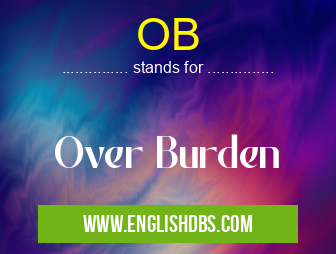What does OB mean in UNCLASSIFIED
OB (Over Burden) refers to the layer of waste rock and soil that covers a mineral deposit. It must be removed before mining can begin. The process of removing overburden is known as overburden removal.

OB meaning in Unclassified in Miscellaneous
OB mostly used in an acronym Unclassified in Category Miscellaneous that means Over Burden
Shorthand: OB,
Full Form: Over Burden
For more information of "Over Burden", see the section below.
Types of Overburden
- Soil: Includes topsoil and subsoil.
- Weathering: Loose rock and minerals created by weathering processes.
- Rock: Solid rock that requires blasting or drilling to remove.
Methods of Overburden Removal
- Excavation: Using large earth-moving equipment to dig and remove overburden.
- Blasting: Using explosives to break up rock overburden.
- Hydraulic Mining: Using high-pressure water jets to wash away overburden.
Benefits of Overburden Removal
- Exposes the mineral deposit for mining.
- Creates stable slopes for mining operations.
- Reduces environmental impacts by removing potentially harmful materials.
Challenges of Overburden Removal
- Cost: Can be a significant expense in mining operations.
- Environmental Considerations: Removal can generate waste and disturb habitats.
- Safety Risks: Blasting and excavation can pose safety hazards.
Essential Questions and Answers on Over Burden in "MISCELLANEOUS»UNFILED"
What is Over Burden (OB)?
Over Burden (OB) refers to the layers of soil, rock, and other materials that lie above a mineral deposit. It must be removed to access the underlying mineral resources.
Why is Over Burden Removed?
Over Burden is removed to expose the mineral deposit and make it accessible for mining. The removal process involves stripping away the overlying layers using various techniques such as blasting, excavation, and draglines.
What are the Challenges of Over Burden Management?
Over Burden management poses several challenges, including:
- Environmental impacts such as soil erosion, water contamination, and habitat loss
- Costly and time-consuming removal process
- Potential for safety hazards during removal and disposal
- Compliance with environmental regulations and permits
How is Over Burden Disposed of?
Over Burden disposal methods vary based on the type of material and the environmental regulations. Common disposal methods include:
- Spoil piles: Forming mounds of Over Burden near the mining site
- Off-site disposal: Transporting Over Burden to designated disposal sites
- Backfilling: Utilizing Over Burden to fill excavated areas after mining operations
What are the Best Practices for Over Burden Management?
Responsible Over Burden management involves:
- Minimizing environmental impacts through effective erosion control measures and proper disposal techniques
- Optimizing resource utilization by reusing Over Burden for backfilling or other purposes
- Ensuring compliance with regulatory requirements and industry standards
- Engaging in stakeholder consultation to address concerns and mitigate potential conflicts
Final Words: OB (Over Burden) is a crucial step in mining operations that involves removing the layer of waste material covering the mineral deposit. Proper overburden removal techniques ensure safe and efficient mining while minimizing environmental impacts.
OB also stands for: |
|
| All stands for OB |
